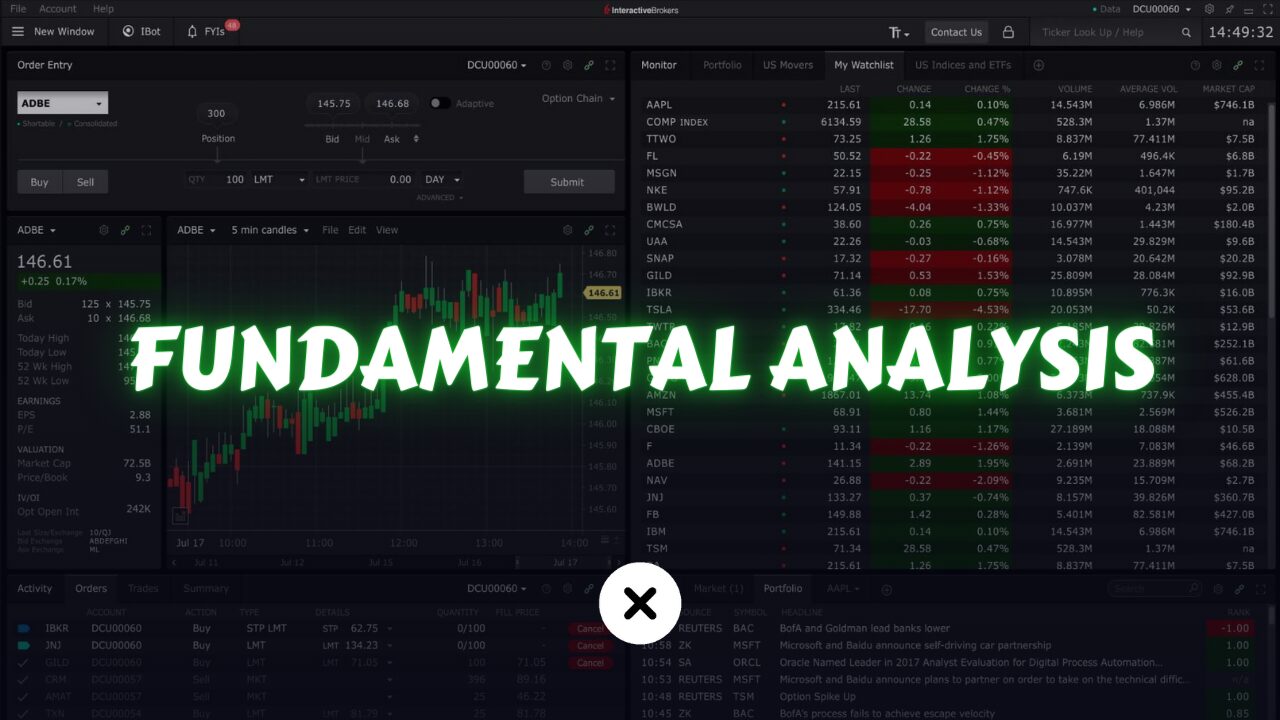
Unlike technical analysis, which focuses on price movements and chart patterns, fundamental analysis delves into the intrinsic value of a company by examining its financial statements, industry trends, and economic indicators.
In this comprehensive guide, we will explore the intricacies of fundamental analysis for stocks and equip you with the necessary skills to navigate the markets confidently.
What is Fundamental Analysis?
Fundamental analysis is a method of evaluating an asset’s intrinsic value by examining the underlying factors that could influence its price.
It involves studying various qualitative and quantitative factors that can affect the value of an asset. such as financial statements, earnings and revenue, industry and market analysis, management evaluation, economic factors, competitive advantage, valuation ratios.
It is commonly used in the analysis of stocks, but it can also be applied to other financial instruments like bonds, commodities, and currencies.
The goal of fundamental analysis is to determine whether an asset is overvalued or undervalued or fairly priced relative to its fundamentals. and make investment decisions based on that assessment.
Technical analysis is typically employed for short-term trading, whereas fundamental analysis is primarily utilized for long-term investment decisions.
What are Financial Statements?

In the realm of finance, it is a requirement for every publicly traded company to release financial statements on a quarterly basis.
A financial statement is a formal record that provides information about the financial activities, performance, and position of a company.
It consists of several key documents that present financial data in a structured and organized manner. The three main types of financial statements are:
- Income Statement
- Balance Sheet
- Cash flow Statement
From these statements, we can evaluate how well a company is doing, and we can gather information about financial ratios such as P/E, Using this data, we can conduct fundamental analysis.
What is an Income Statement?
Also known as Profit and Loss Statement.
This statement summarizes a company’s revenues, expenses, gains, and losses over a specific period, typically a quarter or a year. It shows the company’s net income or net loss by deducting expenses from revenues and provides insights into its profitability.
What is a Balance Sheet?
Also known as Statement of Financial Position.
The balance sheet presents a snapshot of a company’s financial condition at a specific point in time, usually at the end of a reporting period. It lists the company’s assets (such as cash, inventory, property, and investments), liabilities (such as loans and accounts payable), and shareholders’ equity. The balance sheet illustrates the company’s overall financial health and its net worth.
What is a Cash Flow Statement?
This statement provides information about a company’s cash inflows and outflows over a specific period. It categorizes cash flows into three main activities: operating activities (e.g., revenue, expenses), investing activities (e.g., buying or selling assets), and financing activities (e.g., issuing or repaying debt, raising equity). The cash flow statement helps assess a company’s ability to generate and manage cash.
These financial statements are typically prepared in accordance with accounting principles and standards such as Generally Accepted Accounting Principles (GAAP) or International Financial Reporting Standards (IFRS).
For US market SEC’s EDGAR website provides access to these statements.
How to do Fundamental Analysis for Stocks?
The complexity and size of these statements can be hard to understand, which is why some traders might not be interested in fundamental analysis.
But in reality, you don’t need to read these statements or do fundamental analysis yourself.
Let me explain. In finance, there are two main groups: short-term traders who use technical analysis and long-term investors, like portfolio managers, who focus on fundamental analysis.
For example, imagine a portfolio manager running a big fund. They have analysts who specialize in looking at financial statements. These analysts spend a lot of time analyzing the statements and making predictions about specific stocks, like Apple. Based on their analysis, the portfolio manager might decide to buy Apple stock for the fund.
Do we, as traders, need to spend months analyzing these statements ourselves? No. Other analysts have already done that. Instead, we can understand that the stock’s price, or any other asset, is decided by the decisions of short-term and long-term traders. It’s influenced by supply and demand in the market.
Let’s say one group of analysts thinks Apple stock is worth $100, another group thinks it’s worth $80, and another suggests $90. Regardless of the exact numbers, they provide a range of predictions about where they think the stock should trade. If the stock is trading around $95, it falls within that expected price range.
We know these analysts have done their analysis. But if something big happens, like expenses doubling and profits dropping, all analysts are likely to change their valuations. As a result, the stock price would go down because analysts now see the stock differently, and their new analysis suggests it’s worth less.
As traders, we don’t need to do extensive analysis ourselves. Instead, we focus on understanding how analysts and investors analyze stocks. With this understanding, we can interpret how big events or changes might affect their analysis and, in turn, influence the stock’s price. With this knowledge, we can make informed trading decisions based on how these changes are likely to affect the market’s perception and valuation of the stock.
Performing Fundamental Analysis:
This framework guides fundamental analysis, but it’s not essential for you to fully grasp every detail to benefit from it. As mentioned earlier, you just need to understand how it works and what factors are involved. By grasping these basics, you can predict how changes in these factors will impact prices. That’s the key takeaway. As traders, we prioritize strategies over solely relying on fundamental or technical analysis.
This serves as an introductory glimpse into the process. In upcoming articles, we’ll delve deeper into the practical aspects of conducting fundamental analysis for stocks.
1. Research and Selection:
- Start by identifying companies that align with your investment goals and risk tolerance.
- Utilize financial news sources, investment websites, and research reports to gather information about potential investment opportunities.
2. Financial Statement Analysis:
- Obtain the latest financial statements of the company you’re analyzing from reliable sources such as the company’s website or financial databases.
- Analyze key financial metrics such as revenue growth, profit margins, return on equity (ROE), and free cash flow to assess the company’s financial performance and stability.
- Look for trends and anomalies in the financial statements that may indicate underlying strengths or weaknesses.
3. Ratio Analysis:
- Calculate relevant financial ratios such as P/E ratio, P/B ratio, and debt-to-equity ratio to evaluate the company’s valuation and financial health.
- Compare these ratios with industry benchmarks and historical data to gain perspective on the company’s performance relative to its peers and historical trends.
4. Qualitative Analysis:
- Consider qualitative factors such as management quality, competitive advantages, brand reputation, and industry positioning.
- Assess potential risks and uncertainties that may impact the company’s future prospects, including regulatory changes, technological disruptions, and geopolitical events.
5. Valuation:
- Estimate the intrinsic value of the company using valuation models such as discounted cash flow (DCF) analysis, comparable company analysis (CCA), or dividend discount model (DDM).
- Compare your estimated intrinsic value with the current market price to determine whether the stock is undervalued, overvalued, or fairly priced.
6. Monitor and Review:
- Continuously monitor the company’s performance, industry trends, and market conditions to stay informed about any developments that may affect your investment thesis.
- Regularly review your investment portfolio and adjust your holdings accordingly based on changes in fundamentals and market dynamics.
Conclusion
In summary, fundamental analysis is crucial for assessing the true value of assets by analyzing factors such as financial statements and industry trends. By understanding how to conduct fundamental analysis, traders can anticipate how changes in these fundamentals might affect asset prices. This knowledge empowers investors to make informed decisions and navigate the markets successfully, ultimately contributing to long-term financial success.



